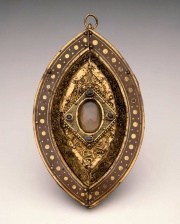Difference between revisions of "Varnish"
(username removed) |
(username removed) |
||
| Line 2: | Line 2: | ||
== Description == | == Description == | ||
| − | Any transparent protective or decorative coating. Varnishes are composed of a resin dissolved in a liquid which dries to form a hard glassy film. Varnish recipes from the 9th century contained a natural resin, such as [http://cameo.mfa.org/materials/fullrecord.asp?name=myrrh myrrh], [http://cameo.mfa.org/materials/fullrecord.asp?name=rosin rosin], [http://cameo.mfa.org/materials/fullrecord.asp?name=mastic | + | Any transparent protective or decorative coating. Varnishes are composed of a resin dissolved in a liquid which dries to form a hard glassy film. Varnish recipes from the 9th century contained a natural resin, such as [http://cameo.mfa.org/materials/fullrecord.asp?name=myrrh myrrh], [http://cameo.mfa.org/materials/fullrecord.asp?name=rosin rosin], [http://cameo.mfa.org/materials/fullrecord.asp?name=mastic%20resin mastic], or [http://cameo.mfa.org/materials/fullrecord.asp?name=sandarac sandarac], dissolved in hot [http://cameo.mfa.org/materials/fullrecord.asp?name=linseed%20oil linseed oil]. Oil varnishes formed dark, strong, insoluble films. By the early 16th century, spirit varnishes are used. Spirit varnishes contained a natural resin dissolved in an evaporating solvent, such as [http://cameo.mfa.org/materials/fullrecord.asp?name=ethyl%20alcohol alcohol] or [http://cameo.mfa.org/materials/fullrecord.asp?name=turpentine%20%28oil%29 turpentine]. By the 19th century, spirit varnishes containing mastic and [http://cameo.mfa.org/materials/fullrecord.asp?name=dammar dammar] were commonly used for picture varnishes while [http://cameo.mfa.org/materials/fullrecord.asp?name=shellac shellac] varnishes were used for furniture finishes. By the mid 20th century, synthetic resin varnishes were used for many types of coatings. Examples of synthetic varnishes are [http://cameo.mfa.org/materials/fullrecord.asp?name=acrylic%20resin acrylic], [http://cameo.mfa.org/materials/fullrecord.asp?name=alkyd%20resin alkyd], [http://cameo.mfa.org/materials/fullrecord.asp?name=polycyclohexanone polycyclohexanone], [http://cameo.mfa.org/materials/fullrecord.asp?name=polyvinyl%20acetate polyvinyl acetate], and [http://cameo.mfa.org/materials/fullrecord.asp?name=polyurethane polyurethane]. |
== Synonyms and Related Terms == | == Synonyms and Related Terms == | ||
| Line 14: | Line 14: | ||
== Authority == | == Authority == | ||
| − | * | + | * Reed Kay, ''The Painter's Guide To Studio Methods and Materials'', Prentice-Hall, Inc., Englewood Cliffs, NJ, 1983 |
| − | * | + | * Ralph Mayer, ''A Dictionary of Art Terms and Techniques'', Harper and Row Publishers, New York, 1969 (also 1945 printing) |
| − | * | + | * ASTM, "Standard Terminology Relating to Paint, Varnish, Lacquer and Related Products", Annual Book of ASTM Standards, Section 6, Paints, Related Coatings and Aromatics, ASTM, D16, 7-Jan, Jul-96 |
| − | * | + | * Matt Roberts, Don Etherington, ''Bookbinding and the Conservation of Books: a Dictionary of Descriptive Terminology'', U.S. Government Printing Office, Washington DC, 1982 |
* ''The Dictionary of Art'', Grove's Dictionaries Inc., New York, 1996 Comment: J.Kirby, "Varnish" | * ''The Dictionary of Art'', Grove's Dictionaries Inc., New York, 1996 Comment: J.Kirby, "Varnish" | ||
Revision as of 06:48, 24 July 2013
Description
Any transparent protective or decorative coating. Varnishes are composed of a resin dissolved in a liquid which dries to form a hard glassy film. Varnish recipes from the 9th century contained a natural resin, such as myrrh, rosin, mastic, or sandarac, dissolved in hot linseed oil. Oil varnishes formed dark, strong, insoluble films. By the early 16th century, spirit varnishes are used. Spirit varnishes contained a natural resin dissolved in an evaporating solvent, such as alcohol or turpentine. By the 19th century, spirit varnishes containing mastic and dammar were commonly used for picture varnishes while shellac varnishes were used for furniture finishes. By the mid 20th century, synthetic resin varnishes were used for many types of coatings. Examples of synthetic varnishes are acrylic, alkyd, polycyclohexanone, polyvinyl acetate, and polyurethane.
Synonyms and Related Terms
"varnishes (pl.); vernis (Fr.); barniz (Esp.); vernice (It) "
Additional Information
J.Kirby, "Varnish" The Dictionary of Art, Grove's Dictionaries Inc., New York, 1996.
Authority
- Reed Kay, The Painter's Guide To Studio Methods and Materials, Prentice-Hall, Inc., Englewood Cliffs, NJ, 1983
- Ralph Mayer, A Dictionary of Art Terms and Techniques, Harper and Row Publishers, New York, 1969 (also 1945 printing)
- ASTM, "Standard Terminology Relating to Paint, Varnish, Lacquer and Related Products", Annual Book of ASTM Standards, Section 6, Paints, Related Coatings and Aromatics, ASTM, D16, 7-Jan, Jul-96
- Matt Roberts, Don Etherington, Bookbinding and the Conservation of Books: a Dictionary of Descriptive Terminology, U.S. Government Printing Office, Washington DC, 1982
- The Dictionary of Art, Grove's Dictionaries Inc., New York, 1996 Comment: J.Kirby, "Varnish"
- Dictionary of Building Preservation, Ward Bucher, ed., John Wiley & Sons, Inc., New York City, 1996
- Art and Architecture Thesaurus Online, http://www.getty.edu/research/tools/vocabulary/aat/, J. Paul Getty Trust, Los Angeles, 2000
